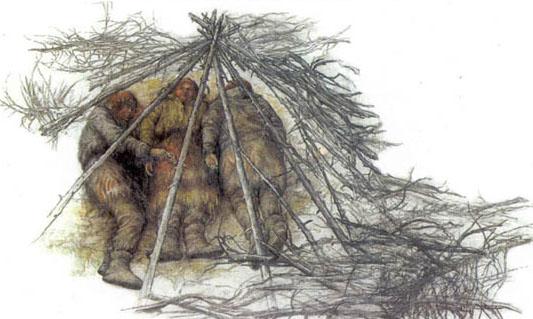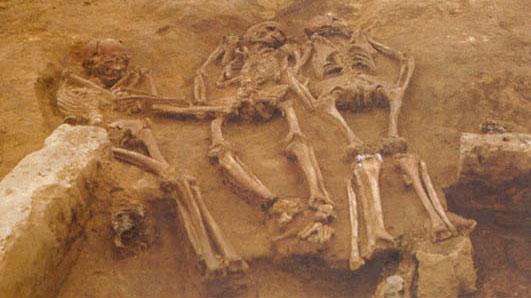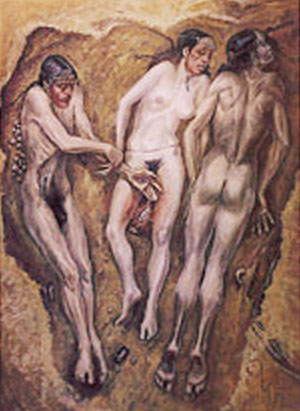Back to Don's Maps
Dolni Vestonice, the kiln of S'Armuna, and the Three Sisters
The Multiple Burial from Dolni Vestonice II
 |
|
|
|
 |
 |
|
|
|
 |
In the spring of 1986, near a village called Dolni Vestonice in the Czech province of Moravia, the bodies of three teenagers were discovered in a common grave. A specialist was immediately summoned from Brno, some twenty-five miles to the north, and under his care the remains were exhumed and faint remnants of the youths' identities revealed. Two of the skeletons were heavily built males. By its slender proportions, the third was judged to be female, aged seventeen to twenty. A marked left curvature of the spine, along with several other skeletal abnormalities, suggested that she had been painfully crippled. The two males had died healthy, in the prime of their lives. The remains of a thick wooden pole thrust through the hip of one of them hinted that his death might not have been entirely natural.
The bodies had been buried with curious attention. According to the expert Bohuslav Klima, of the Czech Institute of Archaeology in Brno both young men had been laid to rest with their heads encircled with necklaces of pierced canine teeth and ivory; the one with the pole thrust up to his coccyx may also have been wearing some kind of painted mask. All three skulls were covered in red ocher. The most peculiar feature of the grave, however, was the arrangement of the deceased. Whoever committed the bodies to the ground extended them side by side, the woman between her two companions. The man on her left lay on his stomach, facing away from her but with his left arm linked with hers. The other male lay on his back, his head turned toward her. Both of his arms were reaching out, so that his hands rested on her pubis. The ground surrounding this intimate connection was splashed with red ocher.
The skeletons lean into each other, like nestled question marks. In his written report, Klima speculated that the arrangement of the grave might reflect "a real life drama which precipitated the burials." His drama revolved around a young woman who had died in childbirth. The two male skeletons where those of her husband and a medicine man-the man wearing the mask. Held responsible for her death, the men had been compelled to follow her into the afterlife.
***************
From:
http://www.geocities.com/Athens/6293/series/bk4moravia.htm
In August, 1986 this multiple burial was unearthed. It was a shallow pit grave located near hearths carbon-dated to about 26,000 years ago. The remains were of an individual of undetermined sex in the center, who had spinal scoliosis, an asymmetrical skull, and an underdeveloped right leg. On the left is a male reaching toward some red ochre located between the legs of the middle body. A larger male on the right is laying face down. The male skulls were adorned with circles of arctic fox teeth, wolf teeth and ivory beads.
From the book 'Plains of Passage' by Jean Auel:
Stretched out on the ground were three people - young, probably late teens or early twenties, he guessed. Two of them were definitely male; they were bearded. The biggest one was probably the youngest. His light facial hair was still somewhat sparse. ... The third one was fairly tall but thin, and something about the body and the way it lay made him wonder if that person had had some physical problem. He could see no facial hair, which made him think it was a woman at first, but it also could have been a rather tall young man who shaved, just as easily.
With no burial shrouds, the bodies were simply carried to a single shallow grave one at a time. ... The tall, thin body went in first, placed on its back, and powdered red ochre was sprinkled on the head and, strangely, over the pelvis; the powerful generative area, making Jondalar wonder if, perhaps, it was indeed a woman.
The other two were handled differently, but even more strangely. The brown-haired male was put in the common grave, to the left of the first corpse from Jondalar's viewpoint, but on the figure's right, and placed on his side, facing the first body. Then his arm was stretched out so that his hand rested on the red-ochred pubic region of the other. The third body was almost thrown into the grave, facedown, on the right side of the body that had been put in first. Red ochre was also sprinkled on both of their heads. The sacred red powder was obviously meant for protection, but for whom? And against what?
*********************
From:
http://emuseum.mnsu.edu/archaeology/sites/europe/dolni_vestonice.html
"Where the two rivers came together and the wet ground sustained the tender grasses of spring, the woolly mammoth...grazed, and the people...hunted and lived on the swamp." -James Shreeve
Dolni Vestonice was an Upper Paleolithic habitation in Czechoslovakia on a swamp at the joint of two rivers near the Moravian mountains. In the spring of 1986, near the village of Dolni Vestonice, the remains of three teenagers were discovered in a common grave. Approximatley 27,640 years had passed from the time of the burial until they were found. Two of the skeletons were heavily built males while the third was judged to be a female based on its slender proportions. Archaeologists who examined her skeletal remains found evidence of a stroke or other illness which left her painfully crippled and her face deformed. The two males had died healthy, but remains of a thick wooden pole thrust through the hip of one of them suggests that the death didn't happen naturally. On the ground surrounding the burial site, red ocher powder was splashed, which was thought to be for protection.
Dolni Vestonice is also the site of the earliest known potter's kiln. For acres around, the fertile clay soil is seeded with carved and molded images of animals, women, strange engravings, personal ornaments, and decorated graves. In the main hut, where the people ate and slept, two items were found: a goddess figurine made of fired clay and a small and cautiously carved portrait made from mammoth ivory of a woman whose face was drooped on one side.
The goddess figurine is the oldest known baked clay figurine. On top of its head are holes which may have held grasses or herbs. The potter scratched two slits that stretched from the eyes to the chest which were thought to be the life-giving tears of the mother goddess.
Above the encampment in a small, dry-hut, whose door faced towards the east, was the kiln. Scattered around the oven were many fragments of fired clay. Remains of clay animals, some stabbed as if hunted, and other pieces of blackened pottery still bear the fingerprints of the potter.
***************
From:
http://www.calacademy.org/calwild/sum99/symbol.htm
Some 26,000 years ago, a resident of a seasonal, open-air encampment in what is now the southern Czech Republic kneaded moist clay mixed from local soil into an exaggerated portrait of a woman. The so-called Black Venus of Dolni Vestonice I has a featureless, possibly masked, face, squared shoulders, pendulous breasts, and a belt beneath her broad hips. Only four inches tall, she is one of the earliest known depictions of a female figure, but what inspired her creation is cloaked in mystery.
A jagged crack runs along her right hip, damage sustained when the clay figurine was fired in a kiln at temperatures up to 1,500 �F. More than 700 figurines-nearly all depicting Ice Age animals such as lions, rhinos, and mammoths-were fired in the oval earthen kilns of Dolni Vestonice. At nearby sites of similar age, thousands more terracotta figurines and clay pellets have been excavated. Almost all the Vestonice figurines exhibit breaks and cracks-the shattering shock of the flames that baked them. Were the world's first ceramic artists also the world's worst craftsmen, or were these figures props for a pyrotechnic ritual?
Elsewhere at Dolni Vestonice, a grave excavated in 1986 contained the skeletons of two young men and a woman. Inside the shallow burial pit lay bits of reindeer bones, and wolf and fox teeth. Red ocher powder had been sprinkled around each skull and between the legs of the female, who had a deformed spine and right leg. One male's hand had been placed atop the female's pelvis, while the other male's skull had been smashed at the time of burial.
******************